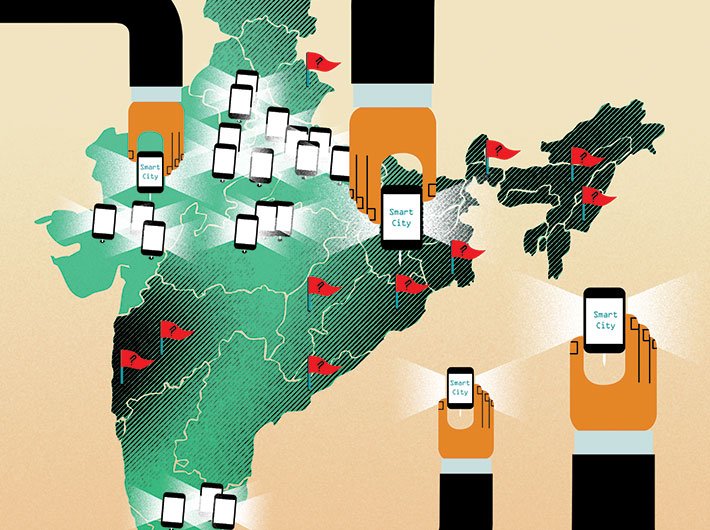If the smart cities are also to serve as lighthouses, they must be spread across the peninsula rather than being mostly clustered in a few states
With the list for 100 smart cities mostly in, the stage 1 of Smart Cities Mission is over and the cities are readying for the challenge round as part of stage 2. At this first milestone, it may do the project some good to check if we are on the right track and if any course correction could be useful.
First thing first: is the state-wise distribution of cities on the list reading alright? Are we still sure that people across the country are getting fairly represented?
To me — and to some other people I spoke with — the distribution looks somewhat odd and unequitable. For instance, how come the most populous state of Uttar Pradesh gets 13 cities and Tamil Nadu with a little more than one-third of UP’s population also manages to have 12 while the second-most populous Maharashtra gets only 10? Also, Bihar and West Bengal, which have the third -- and fourth-largest populations -- are allocated mere three and four smart cities, respectively.
No, I’m not missing out the fact the number of smart cities per state has been determined using a comprehensive mechanism that takes into account a number of parameters, including the urban population of the state, number of statutory towns, existing service levels, institutional systems/capacities, self-financing and past track records and reforms.
While the selection of the parameters may be arguably fine, the stage at which they were applied is most certainly not. Let’s try seeing why, because as we said, a course correction is quite doable at this early stage.
It’s all about people first, isn’t it?
It is, indeed. As the Smart Cities Mission statement from ministry of urban development (MoUD) notes, “The focus is on sustainable and inclusive development and the idea is to look at compact areas, create a replicable model which will act like a light house to other aspiring cities.”
What is sustainable and inclusive development and how do we achieve that? This is the first and most fundamental question, and an earnest answer to this is what could keep steering the mission in the right direction. Let’s attempt arriving at some essentials.
Sustainable development is universally defined as one that focuses not just on economic development but also on social and environmental developments — the three ‘P’s as they say, of profit, people and planet.
In fact, the term “inclusive,” which is essentially about ensuring that the benefit of a development reaches the masses at the bottom of a socioeconomic pyramid, is already covered under the term “sustainable.” The use of both the terms in the mission document is undoubtedly to underscore the focus on people, for without their well-being there can’t be the nation’s well-being.
And of course, given that the 100 — or more — smart cities are also to serve as “light houses,” they must be spread across the peninsula. The purpose is hardly served if they are mostly clustered in a few places.
So, it’s got be about states also
It’s a harsh reality that ever since independence, some states have received more than a fair share of the developmental thrust while some others have languished in the absence of it. So much so that certain states like Uttar Pradesh, Bihar and West Bengal, which were at a forefront earlier and were home to some of the most prominent industries in the country, happened to fall out of developmental favors somewhere down the line. That, at least in part, led to mass frustrations, social conflicts and rise in corruption, among other ills that were exploited by demagogues from time to time, only to push these states into more vicious cycles of freefall. Some, like those in the northeast, have been perennially under-attended.
True, often the rise of local factors contributes to the freefalls but then the centre has a role to play in developing mechanism by way of which local social and political detriments could be offset in the best interests of the larger nation and its people.
Sticking to today’s context, the smart cities project could become one such powerful mechanism, especially with its well pronounced focus on sustainability and inclusiveness.
In order to do so, however, it is important to ensure that each state is allocated a share of to-be-developed smart cities in proportion of its overall population — and not just urban population — as that would only perpetuate a skew that has been created due to historical flaws.
It’s always better late than never
The good thing is that it’s anyway not much late either. While the list of 100 cities has been drawn, it’s not that all those cities are going to get the green signal — and funding — from MoUD in one tranche. The cities have to compete with each other to become part of the first batch of the project, and a total of 20 cities are likely to pass the screening tests.
The other cities would get to compete and be part of the next batches over the coming years only, so there is enough time and scope to add more cities to the project’s list and make it a list of 150 or 160 or 200 cities, based on how it works out to be. In fact, one of the states, perhaps Tamil Nadu, could serve as a benchmark for determining the number of smart cities for other states.
Hence, for example if Tamil Nadu, which accounts for close to six percent of India’s population is allocated 12 smart cities, then Madhya Pradesh, which is slightly more populous than Tamil Nadu, should also get an approval for 12 smart cities. Yes, using this benchmark, Uttar Pradesh that accounts for more than 16 percent of the country’s population could end up having at least 27 smart cities but then states like Bihar and West Bengal would also get allocated at least 14 and 12 cities, respectively. Maharashtra would get 15 to 16 cities. Likewise, Assam, Jharkhand, Karnataka, Kerala, Orissa and Rajasthan, among others, will also get more.
What would be the advantages?
A course correction at this stage could save the project from following the same skewed development models that most of the earlier projects have espoused. A population-based state-wise allocation of smart cities could even set the stage for correcting the past skews and lead to a more equitable development across the nation.
As of now, the metros and tier-1 cities are literally crumbling under the pressure of large-scale influxes of people from all parts of the country. While water alone has become an increasingly threatened resource, the inability of India’s cities in coping up with thousands of tons of municipal solid waste produced by the dwellers on a daily basis is creating alarming levels of sanitation and healthcare issues, not to talk about a multitude of other complexities. Although smartification of these cities could help address some of the issues, it would still be far from inadequate if the population loads are not kept within manageable limits. Development of smart cities across states, with employment opportunities thoughtfully integrated, could go a long way in relieving the pains of the existing urban centres and make those sustainable as well.
As a corollary to the above, uniform distribution of smart cities would also help optimise the travel to and from the major cities and reduce the carbon footprint of the country as a whole.
Smart cities will likely make the people across different states more aware and conscious about how they use natural resources like water and how municipal solid waste is segregated and managed at the origin itself. More importantly, economically self-sufficient and socially and environmentally aware people would likely make better citizens and even politically more rational and mature.
The Smart Cities Mission presents an excellent leverage for nation building, and government in general and MoUD in particular has the opportunity to make the most out of it.

